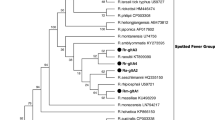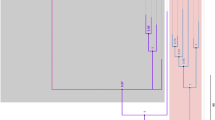Abstract
In humans, emerging infectious diseases are mostly zoonoses with ticks playing an important role as vectors. Tick-borne relapsing fever Borrelia and spotted fever Rickettsia occur in endemic foci along tropical and subtropical regions of the globe. However, both are widely neglected etiologic agents. In this study, we performed molecular analyses in order to assess the presence of Borrelia and Rickettsia DNA in ticks infesting small-mammals within a National Reserve located in the Andes Mountains, central Chile. While hard ticks were negative for the presence of both agents, sequences of four rickettsial (gltA, htrA, ompA, ompB) and two borrelial (16S rRNA and flaB) genes were obtained from larvae of an Ornithodoros sp. morphologically related with Ornithodoros atacamensis. Phylogenetic analyses indicated that the detected Borrelia and Rickettsia spp. belong to the relapsing fever and spotted fever groups, respectively. Moreover, the agents formed monophyletic clades with Rickettsia amblyommatis and “Candidatus Borrelia johnsonii.” As positive ticks parasitize rodents within a highly visited National Reserve where outdoor activities are of common practice, the risk for human parasitism should not be discarded.






Similar content being viewed by others
References
Altschul SF, Gish W, Miller W et al (1990) Basic local alignment search tool. J Mol Biol 215:403–410. https://doi.org/10.1016/S0022-2836(05)80360-2
Ataliba AC, Resende JS, Yoshinari N, Labruna MB (2007) Isolation and molecular characterization of a Brazilian strain of Borrelia anserina, the agent of fowl spirochaetosis. Res Vet Sci 83:145–149. https://doi.org/10.1016/j.rvsc.2006.11.014
Barbour A, Schwan TG (2018) Borrelia. In: Wang G, Schwartz I (eds) Bergey’s manual of systematics of archaea and bacteria. Wiley, in association with Bergey’s Manual Trust, New York. https://doi.org/10.1002/9781118960608.gbm01246.pub2
Carpenter J, Marion CJ (2017) Exotic animal formulary, 5th edn. Elsevier, St. Louis, p 776
Chikeka I, Dumler JS (2015) Neglected bacterial zoonoses. Clin Microbiol Infect 21:404–415. https://doi.org/10.1016/j.cmi.2015.04.022
Cutler SJ (2015) Relapsing Fever borreliae, a global review. Clin Lab Med 35:847–865. https://doi.org/10.1016/j.cll.2015.07.001
Cutler SJ, Ruzic-Sabljic E, Potkonjak A (2017) Emerging borreliae—expanding beyond Lyme borreliosis. Mol Cell Probes 31:22–27. https://doi.org/10.1016/j.mcp.2016.08.003
Davis GE (1952) Observations on the biology of the argasid tick, Ornithodoros brasiliensis Aragão, 1923, with the recovery of a spirochete, Borrelia brasiliensis, n. sp. J Parasitol 38:473–476
Dworkin MS, Schwan TG, Anderson DE, Borchardt SM (2008) Tick-borne relapsing fever. Infect Dis Clin North Am 22:449–468. https://doi.org/10.1016/j.idc.2008.03.006
Estrada-Peña A, Álvarez-Jarreta J, Cabezas-Cruz A (2018) Reservoir and vector evolutionary pressures shaped the adaptation of Borrelia. Infect Genet Evol 66:308–318. https://doi.org/10.1016/j.meegid.2018.03.023
Faccini-Martínez Á, González Tous M, Mattar Velilla S (2018) Fiebre recurrente transmitida por garrapatas: ¿otra etiología subdiagnosticada en Latinoamérica tropical? Rev MVZ Córdoba 23:6399. https://doi.org/10.21897/rmvz.1230
Guglielmone AA, Robbins RG (2018) Hard Ticks (Acari: Ixodida: Ixodidae) PARASITIZING humans. Springer International Publishing, Cham
Guglielmone AA, Acuña DG, Autino AG et al (2005) Ixodes sigelos Keirans, Clifford & Corwin, 1976 (Acari : Ixodidae) in Argentina and southern Chile. Syst Appl Acarol 1976:37–40
Guindon S, Gascuel O (2003) A simple, fast, and accurate algorithm to estimate Large phylogenies by Maximum Likelihood. Syst Biol 52:696–704. https://doi.org/10.1080/10635150390235520
Huelsenbeck JP, Ronquist F (2001) MRBAYES: Bayesian inference of phylogenetic trees. Bioinformatics 17:754–755. https://doi.org/10.1093/bioinformatics/17.8.754
Izzard L, Chung M, Dunning Hotopp J et al (2018) Isolation of a divergent strain of Rickettsia japonica from Dew’s Australian bat Argasid ticks (Argas (Carios) dewae) in Victoria, Australia. Ticks Tick Borne Dis 9:1484–1488. https://doi.org/10.1016/j.ttbdis.2018.07.007
Jongejan F, Uilenberg G (2004) The global importance of ticks. Parasitology 129:S3–S14. https://doi.org/10.1017/S0031182004005967
Kearse M, Moir R, Wilson A et al (2012) Geneious basic: an integrated and extendable desktop software platform for the organization and analysis of sequence data. Bioinformatics 28:1647–1649. https://doi.org/10.1093/bioinformatics/bts199
Keirans JE, Clifford CM, Corwin D (1976) Ixodes sigelos, n. sp. (Acarina: Ixodidae), a parasite of rodents in Chile, with a method for preparing ticks for examination by scanning electron microscopy. Acarologia 18:217–225
Kingry LC, Anacker M, Pritt B et al (2018) Surveillance for and discovery of Borrelia species in US patients suspected of tickborne illness. Clin Infect Dis 66:1864–1871. https://doi.org/10.1093/cid/cix1107
Labruna MB (2009) Ecology of Rickettsia in South America. Ann N Y Acad Sci 1166:156–166. https://doi.org/10.1111/j.1749-6632.2009.04516.x
Labruna MB, McBride JW, Bouyer DH et al (2004a) Molecular evidence for a spotted fever group Rickettsia species in the tick Amblyomma longirostre in Brazil. J Med Entomol 41:533–537. https://doi.org/10.1603/0022-2585-41.3.533
Labruna MB, Whitworth T, Horta MC, Bouyer DH, McBride JW, Pinter A et al (2004b) Rickettsia species infecting Amblyomma cooperi ticks from an area in the state of São Paulo, Brazil, where Brazilian spotted fever is endemic. J Clin Microbiol 42(1):90–98. https://doi.org/10.1128/JCM.42.1.90-98.2004
Li M, Tromp J, Zhang L (1996) On the nearest neighbour interchange distance between evolutionary trees. J Theor Biol 182:463–467. https://doi.org/10.1006/jtbi.1996.0188
Maia MO, Koppe VC, Muñoz-Leal S et al (2018) Detection of Rickettsia spp. in ticks associated to wild mammals in Northeastern Brazil, with notes on an undetermined Ornithodoros sp. collected from marsupials. Exp Appl Acarol 76:523–535. https://doi.org/10.1007/s10493-018-0323-2
Mangold AJ, Bargues MD, Mas-Coma S (1998) Mitochondrial 16S rDNA sequences and phylogenetic relationships of species of Rhipicephalus and other tick genera among Metastriata (Acari: Ixodidae). Parasitol Res 84:478–484
Marinkelle CJ, Grose ES (1968) Species of Borrelia from a Colombian Bat (Natalus tumidirostris). Nature 218:487
Millán J, Peña E (2000) Plan de manejo Reserva Nacional Río de Los Cipreses periodo 2000–2004. Ministerio de Agricultura - CONAF, Santiago
Muñoz-Leal S, Venzal JM, González-Acuña D et al (2016) A new species of Ornithodoros (Acari: Argasidae) from desert areas of northern Chile. Ticks Tick Borne Dis 7:901–910. https://doi.org/10.1016/j.ttbdis.2016.04.008
Muñoz-Leal S, Faccini-Martínez ÁA, Costa FB et al (2018) Isolation and molecular characterization of a relapsing fever Borrelia recovered from Ornithodoros rudis in Brazil. Ticks Tick Borne Dis. https://doi.org/10.1016/j.ttbdis.2018.03.008
Muñoz-Leal S, Lopes MG, Marcili A et al (2019) Anaplasmataceae, Borrelia and Hepatozoon agents in ticks (Acari: Argasidae, Ixodidae) from Chile. Acta Trop 192:91–103. https://doi.org/10.1016/j.actatropica.2019.02.002
Nava S, Venzal JM, González-Acuña D et al (2017) Ticks of the Southern Cone of America: diagnosis, distribution and hosts with taxonomy, ecology and sanitary importance. Elsevier, Academic Press, New York
Nicholas KB, Nicholas HB, Deerfield D (1997) GeneDoc: analysis and visualization of genetic variation. Embnew News 4:14
Nováková M, Costa FB, Krause F et al (2016) Rickettsia vini n. sp. (Rickettsiaceae) infecting the tick Ixodes arboricola (Acari: Ixodidae). Parasit Vectors 9:1–8. https://doi.org/10.1186/s13071-016-1742-8
Ogrzewalska M, Pacheco RC, Uezu A et al (2008) Ticks (Acari: Ixodidae) infesting wild birds in an Atlantic forest area in the state of São Paulo, Brazil, with isolation of Rickettsia from the tick Amblyomma longirostre. J Med Entomol 45:770–774. https://doi.org/10.1093/jmedent/45.4.770
Parola P, Ryelandt J, Mangold AJ et al (2011) Relapsing fever Borrelia in Ornithodoros ticks from Bolivia. Ann Trop Med Parasitol 105:407–411. https://doi.org/10.1179/1364859411Y.0000000021
Parola P, Paddock CD, Socolovschi C et al (2013) Update on tick-borne Rickettsioses around the world: a Geographic approach. Clin Microbiol Rev 26:657–702. https://doi.org/10.1128/CMR.00032-13
Pritt BS, Respicio-Kingry LB, Sloan LM et al (2016) Borrelia mayonii sp. nov., a member of the Borrelia burgdorferi sensu lato complex, detected in patients and ticks in the upper midwestern United States. Int J Syst Evol Microbiol 66:4878–4880. https://doi.org/10.1099/ijsem.0.001445
Raoult D, Fournier PE, Eremeeva M et al (2005) Naming of rickettsiae and rickettsial diseases. Ann N Y Acad Sci 1063:1–12. https://doi.org/10.1196/annals.1355.002
Ras NM, Lascola B, Postic D, Cutler SJ, Rodhain F, Baranton G, Raoult D (1996) Phylogenesis of relapsing fever Borrelia spp. Int J Syst Bacteriol 46(4):859–865. https://doi.org/10.1099/00207713-46-4-859
Regnery RL, Spruill CL, Plikaytis BD (1991) Genotypic identification of Rickettsiae and estimation of intraspecies sequence divergence for portions of two rickettsial genes. J Bacteriol 173(5):1576–1589
Roux V, Raoult D (2000) Phylogenetic analysis of members of the genus Rickettsia using the gene encoding the outer-membrane protein rOmpB (ompB). Int J Syst Evol Microbiol 50:1449–1455
Roux V, Fournier PE, Raoult D (1996) Differentiation of spotted fever group rickettsiae by sequencing and analysis of restriction fragment length polymorphism of PCR-amplified DNA of the gene encoding the protein rOmpA. J Clin Microbiol 34(9):2058–2065
Sanchez JP, Nava S, Lareschi M et al (2010) Host range and geographical distribution of Ixodes sigelos (Acari: Ixodidae). Exp Appl Acarol 52:199–205. https://doi.org/10.1007/s10493-010-9358-8
Sangioni LA, Horta MC, Vianna MCB et al (2005) Rickettsial infection in animals and Brazilian Spotted Fever endemicity. Emerg Infect Dis 11:265–270. https://doi.org/10.3201/eid1102.040656
Schwan TG, Raffel SJ, Schrumpf ME, Policastro PF, Rawlings JA, Lane RS et al (2005) Phylogenetic analysis of the spirochetes Borrelia parkeri and Borrelia turicatae and the potential for Tick-borne Relapsing Fever in Florida. J Clin Microbiol 43(8):3851–3859. https://doi.org/10.1128/JCM.43.8.3851-3859.2005
Schwan TG, Raffel SJ, Schrumpf ME et al (2009) Characterization of a novel relapsing fever spirochete in the midgut, coxal fluid, and salivary glands of the bat tick Carios kelleyi. Vector Borne Zoonot Dis 9:643–647. https://doi.org/10.1089/vbz.2008.0177
Sebastian PS, Bottero MNS, Carvalho L et al (2016) Borrelia burgdorferi sensu lato in Ixodes cf. neuquenensis and Ixodes sigelos ticks from the Patagonian region of Argentina. Acta Trop 162:218–221. https://doi.org/10.1016/j.actatropica.2016.06.030
Silva-Goytia R, Elizondo A (1952) Estudios sobre Fiebre Manchada en México. II. Parásitos hematófagos encontrados naturalmente infectados. Rev Med México 32:278–282
Sonenshine DE, Roe RM (2014) Biology of ticks. Volume I. Oxford University Press, Oxford
Stromdahl EY, Williamson PC, Kollars TMJ, Evans SR, Barry RK, Vince MA, Dobbs NA (2003) DNA evidence of Borrelia lonestari in Amblyomma americanum (Acari: Ixodidae) removed from humans. J Clin Microbiol 41(12):5557–5562. https://doi.org/10.1128/JCM.41.12.5557
Swofford LD (2002) PAUP*: phylogenetic analysis using parsimony (* and other methods). Sinauer Associates, Sunderland
Tahir D, Socolovschi C, Marié J-L et al (2016) New Rickettsia species in soft ticks Ornithodoros hasei collected from bats in French Guiana. Ticks Tick Borne Dis 7(6):1089–1096. https://doi.org/10.1016/j.ttbdis.2016.09.004
Tamura K, Peterson D, Peterson N et al (2011) MEGA5: molecular evolutionary genetics analysis using maximum likelihood, evolutionary distance, and maximum parsimony methods. Mol Biol Evol 28:2731–2739. https://doi.org/10.1093/molbev/msr121
Thompson JD, Higgins DG, Gibson TJ (1994) CLUSTAL W: improving the sensitivity of progressive multiple sequence alignment through sequence weighting, position-specific gap penalties and weight matrix choice. Nucleic Acids Res 22:4673–4680. https://doi.org/10.1093/nar/22.22.4673
Webb L, Carl M, Malloy DC, Dasch GA (1990) Detection of murine typhus infection in fleas by using the polymerase chain reaction. J Clin Microbiol 28(3):530–534
Weinert L, Werren JH, Aebi A et al (2009) Evolution and diversity of Rickettsia bacteria. BMC Biol 7:6. https://doi.org/10.1186/1741-7007-7-6
Acknowledgements
We thank Hugo Durán for his valuable help during fieldwork and CONAF personnel for logistic support within the RCNR. Fieldwork and the collection of samples were funded by the “Fondo Científico del Alto Cachapoal versión 7 – Pacific Hydro Chile”. Laboratory work was funded by the Fundação de Amparo à Pesquisa do Estado de São Paulo (FAPESP). SML was funded by FAPESP (Grant #2018/02521-1). DFC was funded by the Comisión Nacional de Investigación Científica y Tecnológica (CONICYT, Grant BCH #72170436).
Author information
Authors and Affiliations
Contributions
SML and MBL conceived the study. SML, DFC, and MA made vertebrate capture and tick collection in the field. SML identified ticks, performed laboratory work, and drafted the manuscript. SML and AM performed phylogenetic analyses. All authors contributed to reviewing the manuscript, read, and approved the final version.
Corresponding author
Ethics declarations
Conflict of interest
On behalf of all authors, the corresponding author states that there is no conflict of interest.
Ethical approval
Animal captures, handling, and the collection of biological samples have been approved by the “Corporación Nacional Forestal” (CONAF) and by permit 417/2018 given by the “Servicio Agrícola y Ganadero” (SAG), Chile. All applicable international, national, and institutional guidelines for the care and use of animals were followed.
Additional information
Publisher's Note
Springer Nature remains neutral with regard to jurisdictional claims in published maps and institutional affiliations.
Electronic supplementary material
Below is the link to the electronic supplementary material.
Rights and permissions
About this article
Cite this article
Muñoz-Leal, S., Marcili, A., Fuentes-Castillo, D. et al. A relapsing fever Borrelia and spotted fever Rickettsia in ticks from an Andean valley, central Chile. Exp Appl Acarol 78, 403–420 (2019). https://doi.org/10.1007/s10493-019-00389-x
Received:
Accepted:
Published:
Issue Date:
DOI: https://doi.org/10.1007/s10493-019-00389-x




